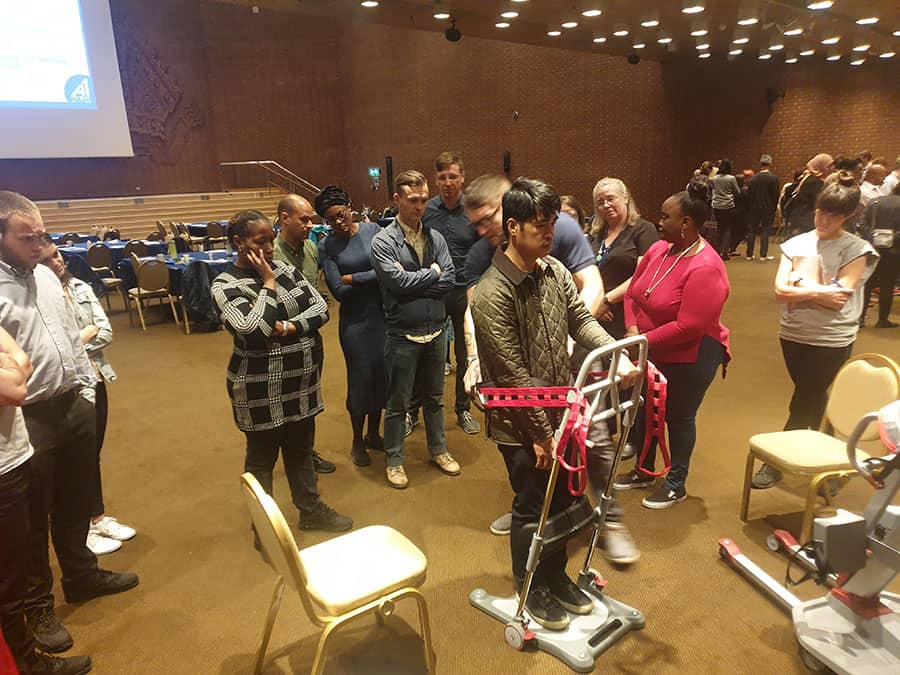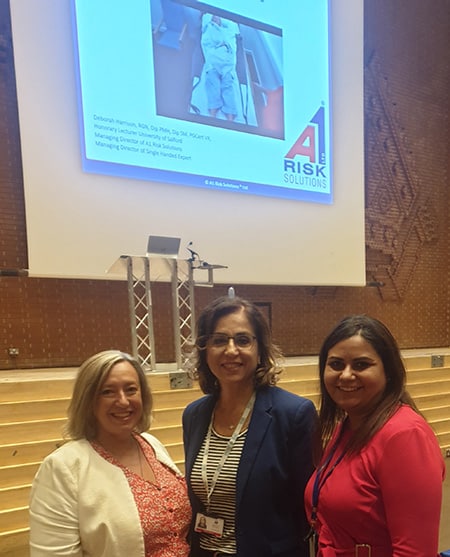Single-Handed Care Part Two: The winning formula

handling, training, risk assessment and consultancy. Deborah started as a nurse and furthered her post-graduate studies in moving and handling, ergonomics and vocational rehabilitation. Deborah has an active role on the ISO committee working on the international standards for hoists and slings.
Single-handed care (SHC) has been around for many years, however, many authorities have not yet adopted this working methodology.
This is the second in a series of three articles concerning SHC, designed to help anyone interested in implementing such a policy. Each article is based on extensive service evaluation and real-life experiential studies carried out by A1 Risk Solutions.
- Part One: Exploring barriers, who you should engage with and potential benefits.
- Part Two: Examine the principle barriers in depth, introduce the concept of an engagement day, provide ideas on setting this up, and explain how it will help implementation of your SHC strategy.
- Part Three: Explore an alternative method of implementing SHC care across health and social care.
The aim of this three-part series is to: assess the impact that adopting SHC has had on local authorities and NHS organisations, evaluate the success stories, and explore what lessons can be learned and how the future may look.
Recognising barriers and creating sustainable solutions is a vital part of setting up a SHC programme. In article one, we identified a range of barriers. In this article, we look closer at two of the principle sources: the carer workforce and SHC assessors. The latter group is usually comprised of OTs and moving & handling professionals.
Part Two: Examine the principle barriers in-depth, introduce the concept of an engagement day, provide ideas on setting this up, and explain how it will help implementation of your SHC strategy.

Carer workforce barriers
The care agency workforce is often cited as being particularly resistive and the blame is frequently placed at their door for projects experiencing difficulties.
Identifying the concerns of these stakeholders enables an understanding of where their resistance originates from. From here, it is possible to develop strategies to break down the underlying issues and answer their questions in a sensitive, transparent and collaborative manner.
A1 Risk Solutions has carried out numerous surveys across thousands of carers and discovered three main themes behind carers’ resistance:
- Carers feeling threatened
- Carers being unsure of how SHC will work and being nervous about their ability and risk to themselves
- Carer concerns about risks for the service users with diverse and complex needs
The table below outlines the key barriers under each of these themes. We acknowledge that this is not an exhaustive list, but it serves as an excellent foundation towards understanding the issues.
Concerns expressed by the carer workforce
Theme One: Carers feeling threatened
Will this result in a reduction in my care hours?
I am nervous about trying this myself
I’ve always done it with two, so why change now?
I car share and I do not drive or have a car
I like working with my friend
I don’t feel valued; I am off to work at Aldi!
There is just not going to be enough work to go around, will I lose my job?
You’re only doing this to save money
Theme Two: Carers being unsure how SHC will work and being an additional risk to themselves
I don’t believe I have the skills to do this
I’ve never used this type of equipment before
Will I get twice as much time to deliver the care?
It’s going to be too much hard work doing all this by myself
I don’t feel it is safe; I don’t want to injure my back
I don’t feel confident, I have never done SHC before
I do not feel safe going into a house by myself
Will I get paid more for taking additional responsibility?
Will I get some training and support?
This is not in our policy and procedures
I am new to care, how can I do it by myself?
Who will be liable when something goes wrong?
Theme Three: Carer concerns about the risks for the service user
What about the person whose moving and handling needs change day to day?
I don’t feel it is safe and I don’t want to injure the service user
There are going to be service users who are too big to move by one person
The families will not like it
The service users will not like it, they like and trust me
The service user, due to their dementia, is very difficult to move
Obviously, I will not be expected to move the clients who are distressed
This is just not suitable or dignified for the service user with a terminal illness
It is useful to adopt a few different strategies to address the concerns shown above rather than looking for a single solution. A1 Risk Solutions has noted that the creation of leaflets works really well. These leaflets could take the form of: ‘You said x and we are doing y’. By presenting the information this way it demonstrates that they are being listened to and that real solutions are being sought. Another suggestion is to hold an Engagement Day, which will be covered later in this article. The aim is to overcome the barriers and start to change the culture. This will take time and patience; it will often feel like you have taken two steps forward and several steps back.

SHC assessors’ barriers
Prior to education and training, SHC assessors frequently demonstrate signs of anxiety which can come across as resistance.
Similar to gathering opinions from and about the carer workforce, A1 Risk Solutions carried out several surveys this time involving over 4,000 SHC assessors (Harrison, 2018). With this group, two main themes of resistance emerged:
- Their ability as a SHC assessor.
- The suitability of the SHC approach for the service user with diverse and complex needs.
Many respondents also reported that they find the assessment process intimidating and scary, because of the resistance from the carer workforce and colleagues.
The table below outlines the key barriers under each of these themes. We acknowledge that this is not an exhaustive list, but it serves as an excellent foundation towards understanding the issues.
Concerns expressed by the SHC Assessor
 Theme One: Abilities of SHC Assessor
Theme One: Abilities of SHC Assessor
I have only attended an equipment demo and I forgot most of it
I don’t feel I have the skills to counter the challenges
I find the whole process intimidating and scary
The real reason is to save money
It’s my registration that is on the line if it goes wrong
How can I carry out assessments with SHC when I am unsure myself?
We will not be doing this as it is not a therapeutic approach!
I have deskilled in moving & handling since working in health
How will I know that the care agency is able to provide SHC when I discharge?
Who will do a follow up visit on discharge from the hospital?
Is it not easier to discharge with two and then the community OT picks it up?
Will we be provided with assessment tools?
Will we be provided with training?
I feel nervous doing the assessment in front of the care agency
We have not got systems or processes in place to start this
I am a therapist and I do not want to be continually debating with care staff
It’s the care staff that need training, we just need to tell them what we want doing
Who is going to support me with this?
Surely it’s down to risk assessment as not everyone will get SHC?
I am nervous about trying this myself
What if the service user or family refuses?
Are we going to get the equipment we need in a timely fashion, not specials?
Am I going to get extra time for assessment and reviews?
How are we going to manage the care agency resistance?
I really struggle as I know people will be upset by my assessment
Theme Two: Concerns about assessing the person with complex needs
What about the person whose condition fluctuates?
I don’t feel it is safe and I don’t want to injure the service user
What about the patient with attachments such as tubing?
There are going to be service users who are plus-size who need four not one
The client who is living with dementia can be difficult to hoist when distressed
What about the person who is aggressive?
This is not for the end of life care
The strategies to overcome these barriers are very similar to those used with the carer workforce. In addition to those previously mentioned, the concerns of the therapists need to be addressed with training and support. It is essential that systems and processes are put in place so organisations are working together and not in silos.
Integration of health and social care

Why?
Historically, patients who are hoisted and require care on the bed are discharged from hospital with a care package that includes two carers. If the health sector is on board with SHC, it has been demonstrated that the discharge process speeds up significantly. Successful integration has the potential to deliver considerable benefits at national level by reducing the hospital stay of many vulnerable patients.
In times of crisis, the results would be invaluable. With the real threat of coronavirus, hospital wards will require rapid clearing for the quarantining and treatment of patients. Using the SHC approach in an integrated manner would vastly facilitate this process with considerable moral, health and cost benefits.
A1 Risk Solutions has been involved with two large projects that integrated health and social care, which took an ergonomic systems approach to the delivery of the programme.
The first was as part of a programme funded by NHS Education. A1 Risk Solutions, in 2019/2020, provided training and support to over 250 staff across health and social services. The areas covered Sefton, Chester, Merseyside, Halton, St Helens, Liverpool, Cheshire, Cheshire East and Cheshire West. All of the health therapists that attended embraced the training; they saw it as a development of their skills and after the training, they were keen to put their new skills and knowledge into practice.
They highlighted the barriers from a discharge perspective, as many of them no longer had capacity to carry out home visits for complex cases. A working group consisting of a transformation director, commissioners and heads of services was key in the early adaptation of the project and implementation across all areas. As each area joined the programme at different times, the project leads were offered bespoke support to enable them to successfully drive their own programme forward.
The second large project in 2019/2020 was with Lancashire County Council. After they had successfully piloted the project, the project lead developed a business case and established a team of assessors. A1 Risk Solutions provided support with the implementation and training to over 150 of the workforce of Lancashire County Council. From the outset, health was successfully engaged, though it is worth noting that this was only through the sheer tenacity and determination of the project lead.
As both of these projects have only recently been implemented, it is too early to have gathered and analysed enough relevant data to show the impact on the hospital discharge process. However, the earliest results from Lancashire are very promising:
- January 2019: Number of beds blocked – 79 beds
- January 2020: Number of beds blocked – 29 beds
Both of the above programmes held an engagement day as a means of collaborating with the whole of the workforce across health and social care.
What is an engagement day?

An engagement day is vital for everyone. A1 Risk Solutions identified early on that communication and collaboration had to be a key part of everyone’s strategy.
An engagement day does what it says on the tin: it is a day where all the stakeholders that were identified in article one are invited to an event that showcases “Moving with Dignity using a Single Handed Care approach”.
Prior to the event, A1 Risk Solutions engages with the key players looking to set up the SHC programme. This ensures all the necessary elements are in place prior to engagement day and training. This process can often take upward of six months for the organisation to put in place. These include:
- Assistance with the development of the business case
- Provision of tools for projected spend and investment, taking everything into account and going beyond a simplistic spend to save model
- Establishing a core stock of single-handed care equipment
- Provision of tools for equipment evaluations
- Provision of tools for evaluating of the project
A1 Risk Solutions then conducts an individualised workforce survey, specific to the organisational needs, and formulates the results and key messages so that workforce concerns can be addressed on the day.
The actual event
A typical event involves anything from 100-250 delegates. It comprises two half-day sessions.
Normally, a councillor, director or commissioner does a brief introduction to the SHC Programme, setting the scene. A1 Risk Solutions then delivers a presentation outlining what SHC is all about, exploring what is happening nationally and internationally and how the project will run. A1 Risk Solutions then addresses all the concerns that have been fed through to it via the survey and the project lead.
Following this, there are four or five practical pods that delegates rotate around watching demonstrations of the equipment that is going to be used in the project. To wrap up, A1 Risk Solutions runs a Q&A session. The results of the workforce survey and event feedback is fed back to the organisation.
Engagement days are well received across the whole of the workforce and are an efficient vehicle to introduce the concept of the SHC approach and educate a whole raft of different disciplines with a view to moving the SHC programme forward.
Next time, in part three, we will explore an alternative method of implementing SHC care.



 Theme One: Abilities of SHC Assessor
Theme One: Abilities of SHC Assessor